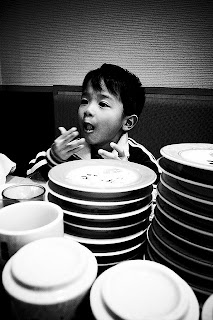| Tuna sushi at a Japanese Sushi Restaurant! (source: wikimedia commons) |
I wasn't surprised when I read a news story about Japan's failure to worry about the current "Tuna Crisis" and that their intent was to acquire the country's favorite food, bluefin tuna, at any cost.
In the recent article "Tuna Collapse Fears Fail to Curb Japan's Appetite" by Associated Press reporter Malcolm Foster, the report focuses on Japan's lack of concern for the dwindling supply of tuna. The country consumes 80% of the prized fish that is sold for as high as $22,000 in Tokyo. Japanese fisherman are fighting with Koreans, Taiwanese, and Mexicans for the lucrative $900M a year wholesale business.
-------------------------------------------------------------------------------------------------------------
COUNTERPOINT:
You have to understand that bluefin tuna is a lucrative business in Japan, especially at the many sushi bars around the country.
Not serving tuna at a Japanese restaurant is the equivalent of not serving steak at an American restaurant.
--------------------------------------------------------------------------------------------
 |
| Bluefin Tuna is a multi-billion dollar business in Japan! (photo courtesy of Ethan Hein) |
The author talks about how the Japanese are not alarmed by the depleting supply of bluefin tuna and that fact has brought only small coverage among the country's media. A scientific study released in January of this year found that the tuna's population has depleted to it's current 3% in the past 15 years. Many cite the decreasing numbers on overfishing of the tuna and the lack of quotas or bans.
A quota was set on the overfishing of the Atlantic tuna--most of it shipped to Japan--and scientists found their numbers recovered slightly last year.
Japan government officials have been avoiding the facts because the fishermen are their constituents and that these companies have never had any restrictions placed on them catching tuna. The Japan Fisheries Agency said that they are self-imposing some restrictions on the industry. However, environmentalists said that the JFA is not doing enough within the country's fishing industry to stop the overfishing.
--------------------------------------------------------------------------------------------------------------
COUNTERPOINT:
The Japanese fishing companies have been spoiled for the past generation (or maybe thousands of years), catching everything with no restrictions. There's no question that fishing for bluefin tuna is a major part of Japan's livelihood.
The industry and the economy are interconnected with each other and that goes for the transportation companies, the markets, the restaurants, and many companies in between. Halting the demand for bluefin tuna would be considered blasphemous in their eyes.
--------------------------------------------------------------------------------------------
Japan says that if they do impose bans and quotas, will other countries also comply? Only a handful of European and U.S. sushi restaurants have taken the bluefin tuna off of their menus in light of the crisis.
Meanwhile, other countries like Korea, Taiwan, and Mexico have NOT imposed any quotas on their fishing vessels. So far, no known restaurant in Japan has publicly removed bluefin tuna from their menus.
--------------------------------------------------------------------------------------------
COUNTERPOINT:
Japan's position on the issue is feeling that they are once again being singled out! Yes, they do consume 80% of the world's bluefin tuna, but other countries have to make sacrifices too!
The issue is similar to the CLIMATE CHANGE policy in which most countries complied to making adjustments in their policies and in their industries to help curb areas that were contributing to "global warming." In the case of the Kyoto Protocol of 2011, the U.S. did not ratify the agreement and Canada dropped out of it.
Japan believes they may find itself in that same position that if they do make that sacrifice, other countries may not do the same.
-------------------------------------------------------------------------------------------
 |
| A young connoissuer plunks down sushi! (photo courtesy of shinosan) |
The Japanese have a "future is NOW" mentality in which most believe that the supply of bluefin tuna will not run out. However, there are a few people, who believe that the supply will be depleted one day, but are not moved enough to do anything about it.
The issue is TOO BIG in Japan and that means stepping on too many toes to enforce a ban on the country's No. 1 delicacy.
Ultimately, to most Japanese, it is difficult to think about banning something that is so delicious! Most consumers think that the controversy is between the Politicians and the Environmentalists and while they let them fight over it, a connoisseur can plunk down that sumptuous morsel from a tuna that cost most people in the world a year's salary.










